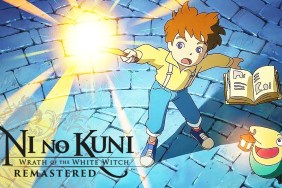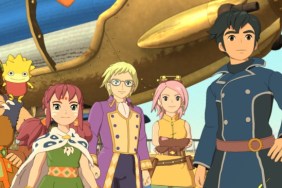Due to the unique nature of its engine, Ni no Kuni: Wrath of the White Witch has impressed pretty much since the first time it was ever unveiled. Level 5’s stunning graphics for the game didn’t involve ridiculously realistic HD or an attempt at a unique approach to cel-shading — it was an attempt at capturing the beautiful and memorable animation style of talented anime studio Studio Ghibli (Howl’s Moving Castle). Ghibli has always been respected for their talents as animators, so any studio trying to bring their work to life in a video game would have no easy task. However, Ni no Kuni isn’t just a pretty face — it’s a game that brings out the essence of Ghibli and combines it with classic RPG elements.
Ni no Kuni is the story of Oliver, a young boy who lives in the town of Motorville. Some time after the beginning events of the game, Oliver’s mother passes away under mysterious circumstances. Oliver is, of course, deeply saddened by this turn of events and cuddles a doll his mother gave him. When he cries on the doll, it turns into an awakened creature named Drippy. Drippy tells Oliver that he is a person that is pure of heart and could be the key to defeating a villain known as Shadar, who is attacking his world. Oliver is given a stick that turns into a magic wand and a weakened magic book with just one spell left in it at the moment: one that will transport him to Drippy’s realm so that he can grow and learn as a magician so that he can defeat Shadar…and maybe find his mother again.
Once in Drippy’s world and upon encountering Esther (a blonde female companion), Oliver has the ability to use “familiars,” monsters that he can train to battle for him. Some familiars come about in the story and others are monsters encountered in combat. A majority of the monsters Oliver encounters are tamable, but have to be battled until the point at which they’re nearly completely drained of HP, at which point the tamable monster will go into an animation that reflects exhaustion. Esther can “serenade” monsters at that point, turning them into familiars. When a familiar has been tamed and is brought into battle, it can earn experience and eventually evolve into a brand new familiar of the player’s choice, somewhat similar to Pokémon.
Speaking of Pokémon, combat in Ni no Kuni is reminiscent of the kind seen in entries in Nintendo’s best-selling franchise, yet with a different approach and somewhat more traditional combat options. Each character in Oliver’s party (which was up to three with the inclusion of a male character named Swaine in one part of the demo) can attack and they can also have three familiars each, each deploying one into combat, but with the ability to swap out the active familiar as long as it hasn’t run out of HP. When a familiar is deployed, their HP and MP bars become the deploying character’s HP and MP bar, meaning that if they fall, so does the character. The player can control Oliver, his familiar, and can switch between control of other characters and their familiars (which can pause the game if the player selects the option to do so). Whether in control of characters or familiars, players select between commands players are used to seeing in RPGs, such as Attack, Magic, special abilities, etc.








